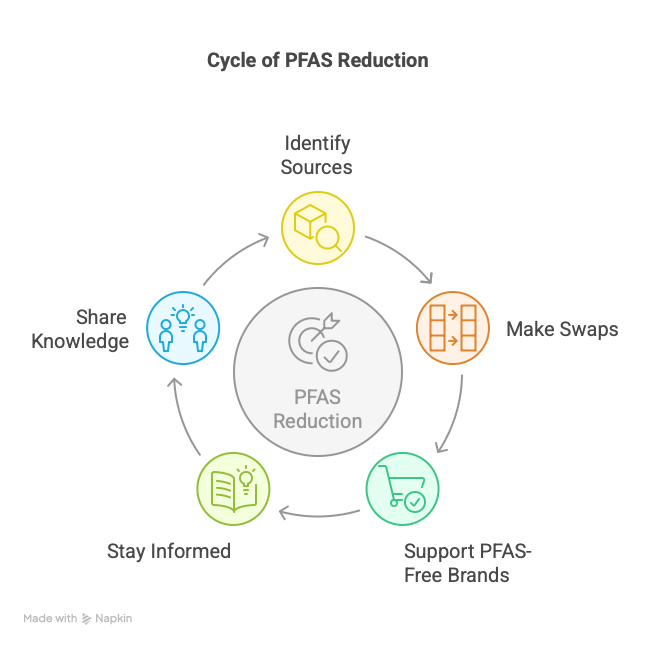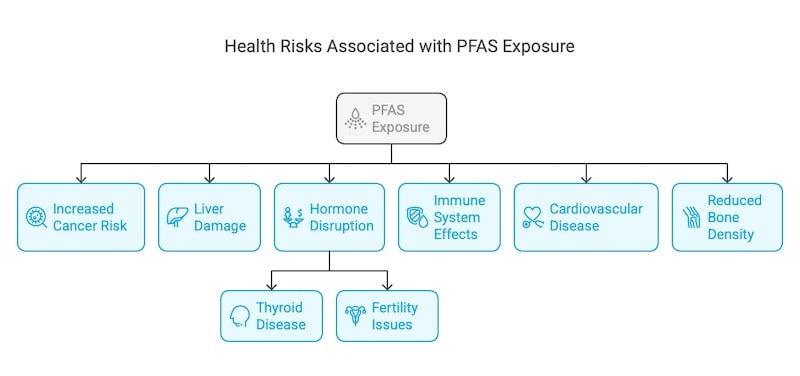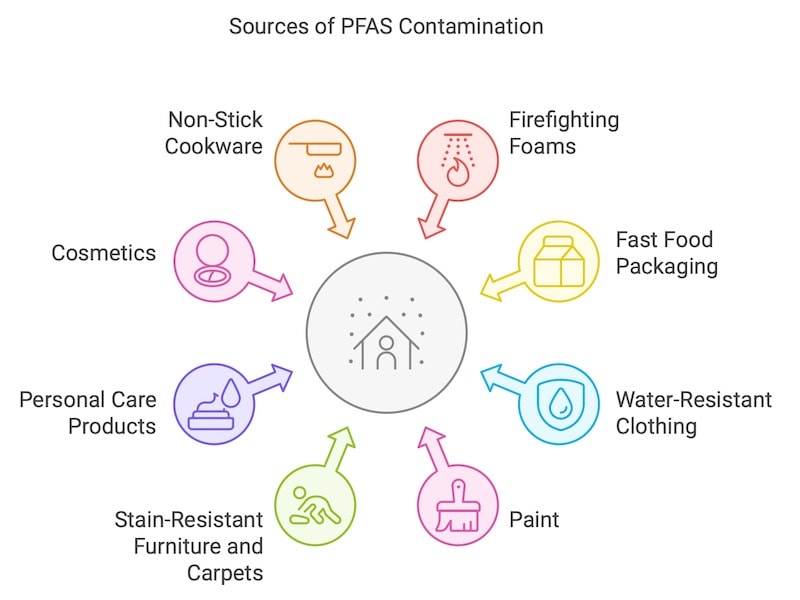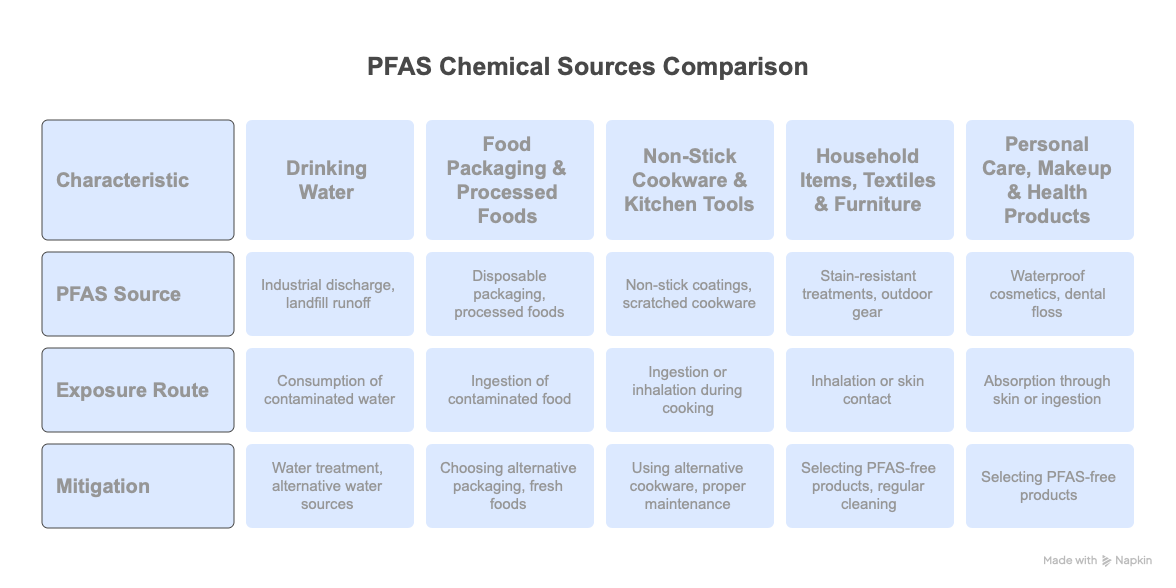Table of Contents
How to Avoid PFAS: 11+ Ways to Reduce Forever Chemicals
This page may contain affiliate links. We may earn a commission on purchases, at no additional cost to you. Learn more →
PFAS might sound like just another complicated science term—but these “forever chemicals” have become one of the most pressing concerns in health and sustainability. From the non-stick pan in your kitchen to the fast-food wrapper you had at lunch and even makeup, PFAS (per- and polyfluoroalkyl substances) are practically everywhere. They’re known for being extremely resistant to heat, water, and grease—and unfortunately, to breaking down in nature.
The not-so-good news? PFAS build up (bioaccumulate) in human body and the environment, potentially impacting our immune systems, hormones, and even our children’s development. Grasping the scale and effects of PFAS is crucial for reducing exposure and protecting our human health.
The good news? While it’s almost impossible to eliminate PFAS exposure entirely, you can significantly reduce it.
Want to know how to avoid PFAS? This guide will show you practical, science-based steps to lower your PFAS intake, protect your health, and make more informed choices for your family—without feeling overwhelmed. Let’s get started!

Key Takeaways
-
Know the Sources: PFAS lurk in everyday items—from drinking water and non-stick pans to fast-food wrappers and mascara. Recognizing these sources helps you take targeted action.
-
Make Simple Swaps: Small changes, like using cast iron instead of scratched Teflon, filtering your water effectively, and checking labels on personal care products, can significantly reduce your PFAS exposure.
-
Check for PFAS-Free: Support brands that are actively phasing out PFAS by looking for “PFAS-free” or safer alternatives. This sends a clear message to manufacturers about consumer demand.
-
Stay Informed & Connected: New research, regulations, and technologies are evolving. Keep an eye on reputable resources, share tips with friends, and learn from others’ experiences.
-
Every Effort Counts: You don’t have to be perfect. Every step you take—no matter how small—contributes to lowering overall PFAS contamination and fosters a healthier future for everyone.

Understanding PFAS: What Are They, Really?
PFAS (per- and polyfluoroalkyl substances) are a large group of man-made chemicals used since the mid-20th century to provide water-proof, grease-proof, stain-resistant, and non-stick properties to thousands of products.
-
Why “forever chemicals”? Because they break down extremely slowly—over potentially hundreds or even thousands of years. Once released, PFAS spread globally via water, air, and soil. Scientists have detected them in human blood, rainwater, polar ice, and even newborn umbilical cords. PFAS half-lives range from 2.3 years (PFBA) to 8.5 years (PFOS) in humans, with no clinically proven detox protocols.
-
Not just one chemical: There are thousands of PFAS variants (some estimates suggest 6,000–10,000+). Older well-known versions like PFOA and PFOS have largely been phased out in some countries due to health concerns, but newer PFAS (like “GenX”) often appear, leading to a cycle experts call “chemical whack-a-mole.”
Why Should You Care About PFAS? Health Risks associated with PFAS
Researchers have associated PFAS exposure with a range of possible health risks:
-
Hormone disruption: PFAS can interfere with thyroid function and other hormone systems.
-
Immune system impacts: Studies suggest they may reduce the body’s immune response, potentially lowering vaccine effectiveness and contributing to inflammation.
-
Developmental and reproductive concerns: PFAS can cross the placenta, accumulate in breastmilk, and have been linked to reduced fertility or effects on fetal growth.
-
Cancer risks: Certain PFAS are linked to higher rates of kidney, testicular, and other cancers in both animals and humans.
-
Cardiovascular and metabolic effects: They may alter lipid metabolism (sometimes called “obesogens”), affecting heart health and weight regulation.
Additionally, PFAS pose serious environmental problems—bioaccumulating in wildlife, contaminating farmland, and leading to widespread water pollution that can devastate communities.
In short, PFAS are worrisome for both personal and planetary health. Though government agencies worldwide have begun tightening regulations, many PFAS remain on the market, and new substitutions keep popping up.

Common PFAS Chemicals Sources
PFAS can hide in unexpected places, thanks to their water-repellant, non-stick, and heat-resistant properties. Being aware of key exposure points is your first step to avoiding them.
Drinking Water
-
PFAS often leach into water supplies via industrial discharges, firefighting foams, landfill runoff, or contaminated soil.
-
Municipal water in many areas has tested positive for PFAS. Some private wells may also be contaminated if located near manufacturing sites or airports/military bases (where PFAS-containing foams were used). Approximately 45% of U.S. drinking water samples contain detectable levels of PFAS, with private wells and public supplies equally affected. A 2024 extreme gradient boosting model estimated that 71–95 million Americans rely on groundwater contaminated with PFAS at depths used for drinking water.
-
Conventional water treatment (including boiling) doesn’t reliably remove PFAS.
Food Packaging & Processed Foods
-
Disposable packaging, like fast-food wrappers, pizza boxes, microwave popcorn bags, and many “grease-proof” or “waterproof” packaging often contain PFAS coatings.
-
Highly processed foods can come into contact with PFAS during production, especially if there’s a lot of plastic tubing or packaging used.
-
Even some “compostable” bowls or paper containers rely on PFAS-based barriers to remain leak-proof.
Research has shown that these chemicals can leach into the food, presenting a health risk upon consumption.
Non Stick Cookware & Kitchen Tools
-
Non-stick cookware (e.g., Teflon) commonly utilize PFAS (although some older forms like PFOA are phased out, “PTFE” still remains). Scratched or overheated coatings can release PFAS into food or air.
-
Certain air fryer baskets or slow cooker liners may also have non-stick coatings containing PFAS.
-
Some bakeware or parchment paper can contain PFAS, though many brands now use silicone-based coatings instead.
-
Plastic containers may also contain PFAS.
Household Items, Textiles & Furniture
-
Stain-resistant carpeting, sofas, and upholstery often have PFAS treatments so spills bead up.
-
Outdoor gear like waterproof jackets, boots, and tents may contain PFAS for water-repellency.
-
Clothing & Activewear: Water-repellent jackets, stain-resistant leggings, and odor-resistant athletic gear often contain PFAS.
-
Period Underwear & Feminine Products: Some brands use PFAS to prevent leaks and stains. Testing has revealed elevated PFAS levels in certain period underwear lines.
-
Household dust can accumulate PFAS shed from coatings over time. Vacuuming or dry sweeping can reintroduce it into the air.
Personal Care, Makeup & Health Products
-
Waterproof or long-lasting cosmetics (mascara, lipstick, foundation) sometimes include PFAS to extend wear or improve spreadability.
-
Dental floss can contain PTFE (a PFAS cousin) for that “slick” glide.
-
Certain sunscreens or lotions also use PFAS to impart water-resistant properties.

What is the best way to avoid PFAS?
11+ Practical Ways to Reduce PFAS Exposure
PFAS exposure is widespread, but you can take meaningful steps to limit it. Think of it like the classic “bear chase” analogy: you don’t need to outrun the bear perfectly—you just want to outrun the slowest runner. Every small reduction in PFAS can help lower your body’s overall load over time.
1. Filter Your Drinking Water Effectively
-
Reverse Osmosis (RO): Consider installing an under-sink RO filter. Studies show RO filters can remove 94% or more of certain PFAS.
-
Distillation units: Some families opt for countertop distillers, which convert water to vapor and condense it, leaving many contaminants behind.
-
High-quality carbon block filters: If RO or distillation is too costly or cumbersome, look for NSF-certified carbon block filters specifically tested for PFOA/PFOS. Results vary, so do your research.
-
Whole-house filters: These can be hit-or-miss for PFAS removal. If you use one, monitor results closely (some systems may even add PFAS if not maintained!).
Tip: You can often find local water testing resources. But since PFAS tests can be expensive, some people skip testing and filter their water by default, assuming PFAS is present.
2. How can I avoid PFAS in food packaging?
-
Steer clear of plastic or paper packaging (like takeout containers) for hot or oily foods. Heat + grease can draw PFAS into the meal.
-
Transfer takeout immediately to your own ceramic or glass plate.
-
Be mindful of items like microwave popcorn—that special bag coating is often PFAS-based. Try stovetop or silicone popcorn poppers instead.
3. Choosing Safe Cookware
Nonstick cookware, often marketed for its convenience, is a common source of PFAS exposure. These chemicals are used to create the nonstick coatings that make cooking and cleaning easier. However, when these pans are heated, PFAS can leach into food, posing health risks. Switch to safer cookware alternatives to avoid these dangers.
-
Opt for stainless steel, cast iron, or enameled cookware—these can be nearly non-stick if seasoned or heated properly.
-
Avoid cooking in Teflon or older non-stick pans, replace it.
-
Check your air fryer liner: Many have non-stick coatings that can chip. Look for PFAS-free or stainless-steel basket options.
-
Some small appliances—like waffle makers, sandwich presses, or pancake griddles—use non-stick PFAS coatings.
-
It’s also important to be cautious of misleading labels. Cookware advertised as ‘PFOA-free’ may still contain other harmful PFAS chemicals. Check for explicit “PFAS-free” or “ceramic-based” non-stick.
4. Choosing Safe Houshold Products
PFAS can be found in a wide range of household products, making it essential to identify and avoid them.
-
Stain-resistant treatments in fabrics and carpets often contain PFAS; check labels before purchasing these items.
-
Cleaning products labeled as ‘waterproof’ or ‘stain-repellent’ may also contain these harmful chemicals.
Overall, avoiding products labeled as water-, grease-, or stain-resistant can help minimize your contact with PFAS.
5. Choose One-Ingredient, Less-Processed Foods
-
Less processing = fewer contact points where PFAS can leach in.
-
Whole foods like fresh produce, meat, fish, eggs, or legumes have less packaging and less industrial handling.
-
This also helps reduce your overall chemical exposure and often improves nutritional quality.
-
Prioritize organic produce, which demonstrates 30–50% lower PFAS levels compared to conventionally grown crops.
6. Inspect Your Personal Care Items and Make Up
Cosmetics are another surprising source of PFAS. Products like foundation, mascara, lipsticks, and moisturizers may contain PFAS for their water-resistant properties.
Some PFAS can unintentionally appear in cosmetics due to raw material contaminants or other contaminants, or the degradation of intentionally added PFAS. The FDA has identified specific PFAS compounds commonly found in cosmetics, including PTFE and perfluorohexylethyl triethoxysilane.
-
Scan labels for PTFE or “fluoro” ingredients in makeup, sunscreen or lotions.
-
Dental Floss: Switch to PFAS-free nylon or silk variants, eliminating PTFE exposure.
-
Aim for “PFAS-free” or verified “clean beauty” lines. Resources like the EWG’s Skin Deep database can help.
-
Remember “BPA-free” isn’t always safe—some brands replaced BPA with “BPS” or “BPF,” which can be just as concerning. Look for truly bisphenol-free or inert packaging (glass, stainless steel).
Choosing safer brands and products helps protect your health and reduce exposure to these toxic chemicals.
7. Swap Out Waterproof & Stain-Proof, and Synthetic Fabrics
-
Raincoats, athletic gear, or upholstery labeled “stain-resistant” or “waterproof” often rely on PFAS.
-
Look for eco-conscious brands specifying “PFAS-free” or note they use alternative treatments (e.g., silicone-based finishes).
-
Use natural fibers and check clothing labels: Look for “PFAS-free” or ask brands about their fabrics, especially for activewear, rain gear, and stain-resistant products.
-
For furniture and carpets, choose natural fibers (wool, cotton, hemp) or untreated upholstery. If needed, try finishing sprays explicitly labeled PFAS-free.
8. Mind Household Dust
-
PFAS from textiles, carpets, or electronics can shed into indoor dust.
-
Vacuum with a HEPA filter weekly to trap micro-particles (including PFAS).
-
Wet mopping floors and damp wiping surfaces helps capture dust instead of stirring it up.
-
Regularly change HVAC filters and air out your home to reduce build-up.
9. Be Wary of “Green” Labels & Chemical Whack-a-Mole
-
Chemical whack-a-mole: Manufacturers often replace one banned PFAS with another closely related chemical.
-
“BPA-free” products may contain “BPS” or “BPF” instead. Similarly, “PFOA-free” could mean “short-chain PFAS” is still used.
-
Look for third-party verifications (like GreenScreen or BPI-certified) that specifically exclude all PFAS forms.
10. Consider Eco-Friendly Alternatives for Everyday Items
-
Use bamboo/coconut fiber dish scrubbers instead of plastic sponges (which can release microplastics).
-
Switch to bamboo toilet paper or unbleached, PFAS-free brands—some standard tissues/toilet paper are treated with chemicals for softness or durability.
-
For leftover storage, pick glass or stainless steel containers over plastic zip bags or wraps.
11. If You Need Water-Resistant Tech, Buy Consciously
-
Certain products (like advanced medical devices, some electronics, or specialized gear) still require PFAS-based components.
-
When possible, check if the brand has begun phasing out PFAS or using safer replacements.
-
Support companies actively seeking PFAS-free solutions—even in high-tech areas like fuel cells or microchips—to drive industry innovation.
Making these changes can significantly reduce your exposure to PFAS.

Testing and Remediation Technologies
Innovative methods are emerging to detect and remediate PFAS:
-
Portable graphene sensors provide high-sensitivity, real-time monitoring for PFAS compounds. They offer a practical way to check local water sources and identify contamination early.
-
Remediation advancements include specialized filtration systems, soil-washing techniques, and high-temperature incineration (though each has its limitations).
By knowing how to test for PFAS and leverage remediation tools, you become part of a broader effort to secure cleaner water and healthier ecosystems.
Consulting Resources and Staying Informed
Reliable information helps you make better decisions:
-
Government agencies: Visit the Agency for Toxic Substances and Disease Registry (ATSDR) and Environmental Protection Agency (EPA) websites to learn about PFAS regulations, health effects, and exposure guidelines.
-
Local water utilities: If you rely on a municipal supply, check their PFAS management data and testing frequency. Ask if filtration or infrastructure updates are planned.
-
Private wells: Regularly test your water to detect PFAS levels. If results are concerning, use a certified water filter or consider alternative sources for cooking and drinking.
-
PFAS-free certifications: Many brands highlight “PFAS-free” labels on cookware, makeup, and even clothing. This can simplify choosing safer products.
-
Keep abreast of ongoing research: Scientists continue to investigate PFAS in consumer goods, like cosmetics, to better understand potential risks.
Staying informed, proactively testing your water, and seeking PFAS-free options all contribute to healthier outcomes for you and your community.
Frequently Asked Questions on PFAS
What foods are high in PFAS?
Studies have detected PFAS in a variety of common foods, with the highest concentrations found in root vegetables like radishes. Other produce containing measurable PFAS levels include carrots, lettuce, green beans, tomatoes, and strawberries, while dairy products like milk and eggs have also shown PFAS contamination. Foods exposed to PFAS-containing packaging, particularly fast food wrappers and "compostable" bowls, may have additional contamination due to chemical migration.
Do Ziploc bags have PFAS?
According to multiple laboratory tests, Ziploc bags do not contain detectable levels of PFAS (per- and polyfluoroalkyl substances), commonly known as "forever chemicals". A study by Mamavation found that while 81% of plastic sandwich bags tested showed indications of PFAS, Ziploc emerged as one of only two brands that tested negative for organic fluorine, a marker for PFAS. Ziploc bags are even used by scientists for collection purposes specifically because they're known to be free of PFAS contamination, making them an exception in the plastic sandwich bag market.
Header Image by Tanya Yarosh auf Unsplash













